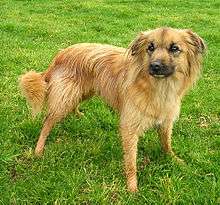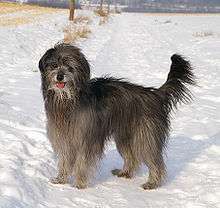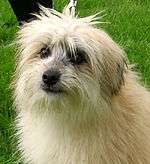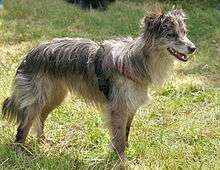Pyrenean Shepherd
 Smooth-faced Pyrenean Shepherd | ||||||||||||||||||||
| Other names |
Berger des Pyrénées Pastor de los Pirineos Petit Berger Pyrenees Sheepdog | |||||||||||||||||||
|---|---|---|---|---|---|---|---|---|---|---|---|---|---|---|---|---|---|---|---|---|
| Common nicknames | Pyr Shep | |||||||||||||||||||
| Origin | France/Spain | |||||||||||||||||||
| ||||||||||||||||||||
| Domestic dog (Canis lupus familiaris) | ||||||||||||||||||||
The Pyrenean Shepherd (known in France originally, and also in non-AKC registries such as the UKC, as the Berger des Pyrénées,[1] and in Spain as the Pastor de los Pirineos) is a medium-small breed of dog native to the Pyrenees mountains in southern France and northern Spain, bred since at least medieval times for herding livestock, especially sheep. It worked as an active herder together with the Great Pyrenees, another mountain dog, which acted as the flock's guardian.
Description
Appearance


The Pyrenean Shepherd is the smallest of the French and Spanish herding dogs. The breed comes in two varieties: Rough-faced and smooth-Faced. Rough-faced males are 15 1⁄2 to 18 1⁄2 inches (39 to 47 cm) at the withers, and rough-faced females are 15 to 18 inches (38 to 46 cm). Smooth-faced males are 15 1⁄2 to 21 inches (39 to 53 cm) at the withers, and smooth-faced females are 15 1⁄2 to 20 1⁄2 inches (39 to 52 cm) inches at the withers. The weight is between 15–32 pounds (7–15 kg), aiming for lithe and muscular, never fat.
The head is of small proportions in comparison to the dog, with a rather flat skull, and a somewhat short, triangular muzzle. The face is expressive and intelligent, with dark eyes, except in the case of merles or slate grey coat colour. Traditionally the dog's ears are cropped. If natural, the Pyrenean Shepherd should have semi-prick or rose ears. Naturally prick ears are not correct for the breed, and may indicate an outcross.
The body is long and lean, and should reflect the natural energetic athleticism of the dog. The legs are well proportioned, with lean, well-angulated, well-let-down hocks typical of a sure-footed mountain breed. The tail can be docked short, a natural bob-tail, or naturally long with a crook in the end, so long as its carried below the topline at rest and in motion.
Coat
The coat has two basic varieties, smooth-faced and rough-faced (demi-long or long-haired). The smooth-faced variety has short, fine hairs on the muzzle, with a modest ruff around the face and neck, and some feathering along the legs, tail, and belly. In contrast, the rough-faced has longer hair on the muzzle and face, though never enough to cover or obscure the eyes or create a bearded effect, and demi-long or long, coarse hair over the rest of the body. The rough-faced dog can also form cords over his hindquarters and front legs.
Color
Shades of fawn are most typical for the breed, either with or without black mask and overlay. Also very common are brindles and various shades of grey. Less common are merles of various kinds (blue merle, brindle merle, fawn merle), and black. All colors allow for some white at the head, chest, and feet, but solid colors are preferred.
Temperament

The Pyrenean Shepherd was designed to be a sheepdog, and as such is full of the same sort of energy that other herding dogs have, but in a surprisingly small package. This adaptive dog wants to, and can, do all the jobs on the field, and is a natural herder. A dog that needs a job, its cleverness makes it ideal for other work and dog sports such as flyball, competitive obedience, and agility. This dog is good with, and protective of, children with whom they were brought up.
Pyr Sheps are "one-man" dogs, attached and dedicated to their owners, with a desire to follow them around the house to help with daily chores. They sense every mood and often seem to be able to read their masters' minds, as they are constantly watchful. Because of this, they are extremely trainable.
Their natural wariness, while valuable in a herding dog which might need to alert their shepherd of strange animals or people, combined with their herding bossiness, can lead to shyness or aggression in even the most friendly puppy if not properly managed. Frequent socialization from a very young age can help counter this trait.
Activities
Pyrenean Shepherds can compete in dog agility trials, obedience, showmanship, flyball, and tracking events.
On 1 January 2009, the Pyrenean Shepherd finally became eligible to compete in herding events in the United States sponsored by the AKC. Herding instincts and trainability can be measured at noncompetitive herding tests. Pyr Sheps exhibiting basic herding instincts can be trained to compete in herding trials.[2]
Care
Pyrenean Shepherds need only a weekly brush, as well as regular checks for burrs or mats, to keep their coat in good condition. They also need a lot of space indoors, and space to exercise outdoors.
History

Some specialists argue that the Pyrenean Shepherd was there long before the arrival of the Roman armies which dominated Gaul and Hispania and this was mixed with large molossers that the Romans had in their army. Other theories suggest that its origin is linked to the passage of the Vandals and Suebi through the Pyrenees to the south.[3]
After the first World War, the Pyrenean Shepherd, or "Pyr Shep", gained national recognition in France for their valiant work as couriers, search and rescue dogs, watch dogs, and company mascots.
The smooth-faced Pyrenean Shepherd in its harlequin or blue merle coloration may have been one of the foundation breeds for the Australian Shepherd when sheep herders brought their sheepdogs to the American West when they flew to the United States as contract herders for the Western Range Association in the 1940s until the early 1970s.[4]
The Pyr Shep is not yet a well-known breed outside of its native France and Spain, but its size, intelligence, and attractive coat make it appealing. After one of its breed won the World Agility Championship for midsized dogs in 2003, it gained more attention as an intelligent performance dog for dog sports.
On 24 January 2015, a male Pyrenean Shepherd, GCh (Grand Champion) La Brise Sun Bear, a dog (i.e., male), was awarded an AKC all-breed Best In Show (BIS). This was the first (and so far only) BIS since having been formally recognized by the AKC for competition (within the Herding Group) effective as of 1 January 2009 (6 years previously).[5][6]
The first Pyrenean Sheepdogs were registered with the Kennel Club (UK) in 1988[7] and the Pyrenean Sheepdog Club of Great Britain was formed in 1992 by a small number of enthusiasts.
References
- ↑ Pyrenean Shepherd Club of America (2013). Pyrenean Shepherd Club of America. Retrieved on 2013-10-13 from http://www.pyrshepclub.com[].
- ↑ Hartnagle-Taylor, Jeanne Joy; Taylor, Ty (2010). Stockdog Savvy. Alpine Publications. ISBN 978-1-57779-106-5.
- ↑ "Pastor de los PIrineos", affiniti-petcare.com
- ↑ http://www.lasrocosa.com/aussiehistory3.html Sheepdogs from Pyrenees region in United States
- ↑ AKC (2015). Pyrenean Shepherd History. Retrieved on 2015-01-26 from http://www.akc.org/breeds/pyrenean_shepherd/history.cfm.
- ↑ Canine Chronicle (2015-01-24). Erie Kennel Club – Saturday, January 24, 2015. Canine Chronicle, 24 January 2015. Retrieved on 2015-01-26 from http://caninechronicle.com/show-wins-gallery/2015101804-erie-kennel-club-inc/.
- ↑ "Breed Info - Pyrenean Sheepdog of Great Britain". www.pyreneansheepdog.co.uk. Retrieved 2016-11-26.
External links
| Wikimedia Commons has media related to Pyrenean Shepherd. |